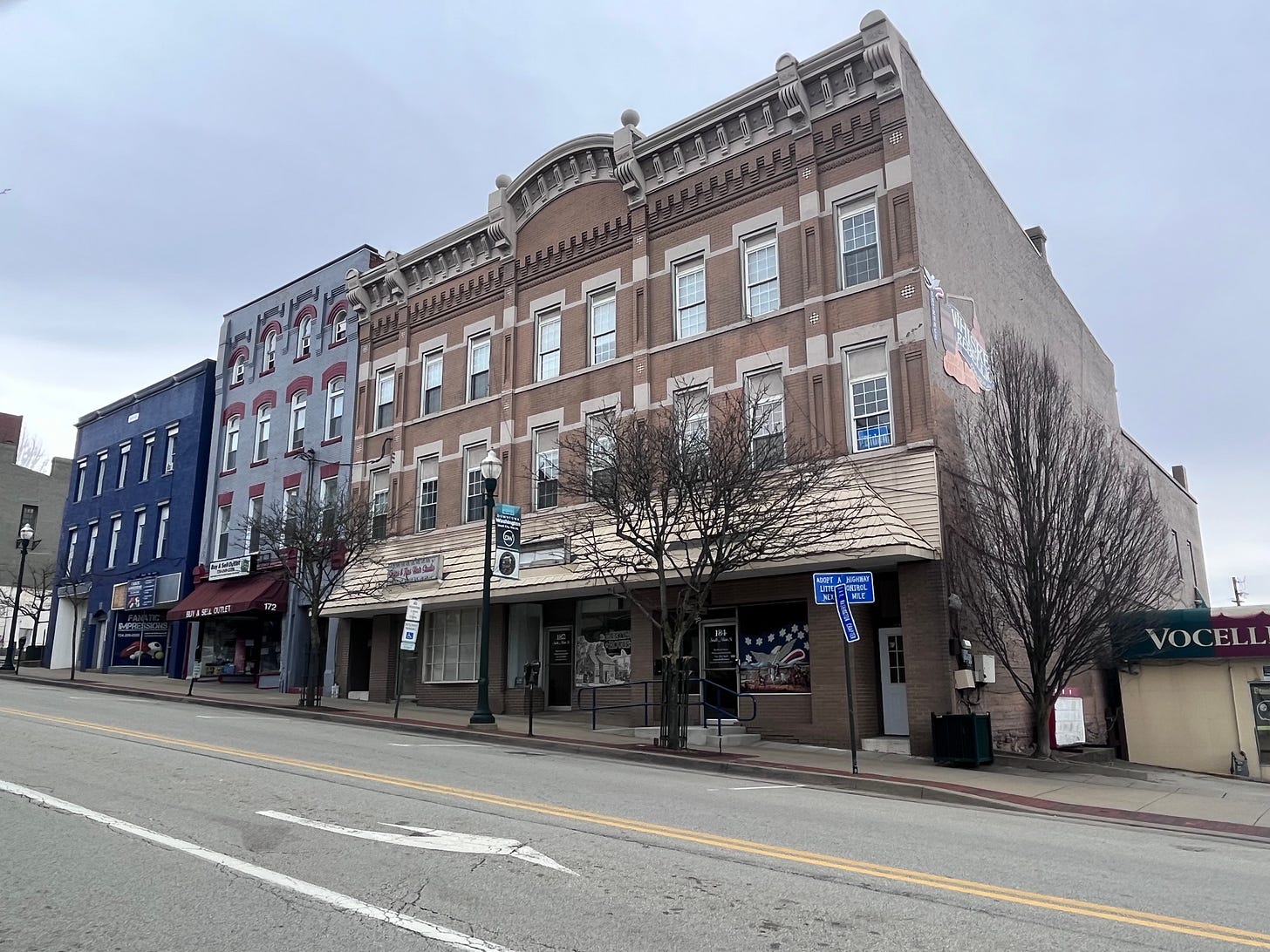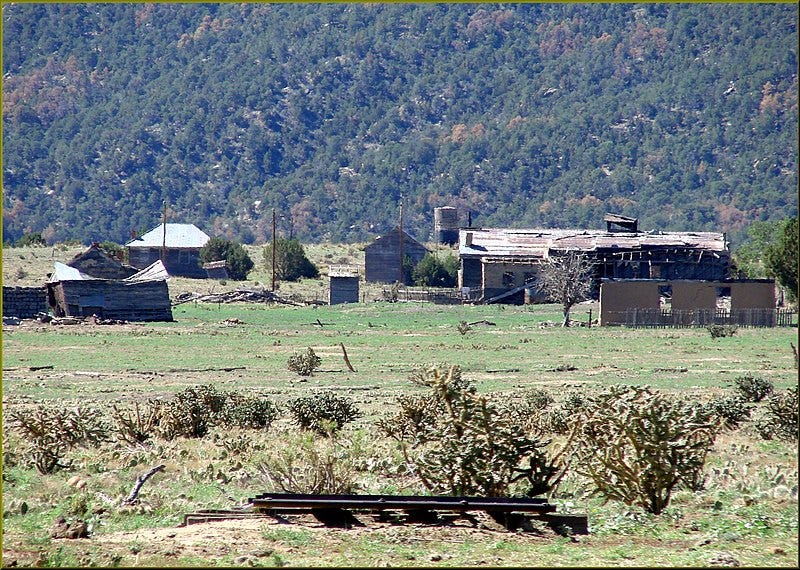
The Romanticized Frontier and the Realities of Extraction
The mythological American frontier is one of rugged individualism, but this narrative often overlooks how government intervention deeply shaped western development. Frontier economies were not self-sufficient; they were subject to taxation, resource extraction, and the economic designs of eastern elites.
Earlier this week, I wrote about the myth of the virtuous American small town.
Monday Thought: Small Towns, Big Myths
Reader Note: Posts will be released between 7 p.m. and 8 p.m. on Monday and Thursday due to increased engagement. Thank you all for supporting this project!
The Whiskey Rebellion is a case study of how federal policies, intended to extract revenue, clashed with frontier communities struggling to survive. Gordon S. Wood chronicles the rebellion through the lens of political infighting and economic sustainability:
This so-called Whiskey Rebellion was the most serious domestic crisis the Washington administration had to face. It came at a frightening time. With the French Revolution creating havoc all over Europe and even threatening to spread to America, the Federalists came to fear that this insurrection in the West might actually lead to the overturning of America’s government and the destruction of the Union. Although it was the largest incident of armed resistance to federal authority between the adoption of the Constitution and the Civil War, it was not the only such incident of rural insurgency; indeed, in the two decades following the Revolution the backcountry of states up and down the continent repeatedly erupted in protest, usually over shortages of money and credit among commercially minded farmers who needed both in order to carry on trade.
-Gordon S Wood, Empire of Liberty
Wood emphasizes the rising democratic conscience of a society that had just fought a war marketed as a struggle for liberty. This fervor is reflected in his discussions of the Constitution’s inception, the rise of political parties, and the economic transformations shaping the young nation. In America’s backcountry—western parts of eastern states like Pennsylvania and Maryland—aversion to government intervention grew as Alexander Hamilton’s Federalist project consolidated control through financial speculation, taxation, and militarism. The tensions between Federalists and the emerging Democratic-Republican movement intensified as the federal government sought to expand its influence over the economy and political order.
Check out the one where I reflect on The Federalist Program:
Reflections on The Federalist Program
I photographed the Inner Harbor as the sun lowered into the distant horizon. Standing before the Maryland Science Center, I thought about times I would visit the building as a child and adult. It has been a staple of my life, but that can’t be said for every generation. The Maryland Science Center began a…
Federalism, the French Revolution, and Economic Extraction
The Democratic-Republican societies emerged in 1793, fueling Federalist fears of radical democracy, especially as the French Revolution intensified. These groups organized against Federalist policies, which they viewed as monarchical and benefiting only a wealthy class of speculators. The Federalists, in contrast, championed a strong central government that could stabilize the economy through taxation and centralized banking.
One of Hamilton’s key initiatives was the whiskey excise tax, first proposed in 1790 and successfully passed in 1791 after a renewed push, partly justified by physicians arguing it could curb heavy drinking. The First National Bank of the United States was another Federalist victory, but it further deepened tensions. Anti-Federalists opposed these policies, believing they concentrated power among financial elites and incentivized corrupt patronage systems. In response, opposition forces mobilized through Democratic-Republican societies and more radical forms of resistance, including attacks on tax collectors.
For Jeffersonian Republicans, the greatest concern was the prospect of a standing army. The fear of an overreaching, militarized federal government intensified when Washington mobilized troops to suppress the Whiskey Rebellion—an act that alarmed those already wary of creeping federal authority, even as they did not yet define themselves as a formal political party.
The Whiskey Excise and Frontier Resistance
Hamilton’s whiskey tax was designed to enhance the federal government’s credibility by securing revenue and stabilizing the postwar economy. It also alleviated state tax burdens by shifting financial obligations to the national level. However, for western farmers, whiskey was more than a commodity—it was a form of trade currency and a practical way to preserve perishable grain. As Wood notes:
“No doubt the allegiance of these Westerners to the federal government, indeed, to any government, was suspect, but with good reason. The frontier settlers were far removed from the centers of government and continually felt that Eastern authorities did not care about protecting them from the Indians or helping them market their crops. Since the Western farmers had difficulty getting their perishable grain to market, they had commonly resorted to distilling that grain into the much more portable and less perishable form of alcohol.”
To many frontier residents, the tax unfairly targeted their livelihood while allowing eastern elites to avoid similar burdens. Over the next few years (1791–1794), resistance escalated from passive non-compliance to violent defiance. By the summer of 1794, 7,000 Pennsylvanians marched on Pittsburgh, threatening residents and plotting to seize a federal arsenal. Similar unrest erupted in western Maryland and Virginia, reflecting a broader rural grievance against centralized authority.
The Federalist Response
Federalists viewed the Whiskey Rebellion as a dangerous challenge to national authority, reminiscent of the instability under the Articles of Confederation. Hamilton urged Washington to take a firm stance, leading to proclamations in 1792 and 1794 condemning the insurrection. When negotiations failed, Washington mobilized a militia of 15,000—larger than the army he commanded during the Revolution—to crush the uprising. The overwhelming display of force ended the rebellion with little bloodshed but established a precedent for using military power to suppress domestic unrest.
Beyond restoring order, Federalists capitalized on the suppression to weaken their political opponents. They linked the Democratic-Republican societies to insurrection, portraying them as radical threats to stability. In a letter to James Monroe, Madison noted that the Federalists sought to associate Republicans in Congress with the rebellion while elevating Washington as the embodiment of responsible governance. Federalists leveraged Washington’s immense popularity to frame the rebellion not as a response to economic hardship but as an existential threat to the republic itself.
Wood captures the sentiments of Federalist leaders while quoting Thomas Slaughter’s 1986 book, The Whiskey Rebellion:
“Because violence and protests in 1791 and 1792 spread through the frontier areas of every state south of New York, the Federalists in the East thought that all order and authority were being challenged and the integrity of the Union itself was threatened. America now had representative republican governments, the ‘friends of order’ said, and there was no longer any need for extra-legislative popular meetings and protests. The citizens’ role in politics was simply to vote for their rulers and representatives and let those who knew better run the government. Allowing the ’rabble’ and the ‘ignorant herd’ to exercise authority, the Federalists said, would lead only to disorder and licentiousness. By defying the excise law, the Westerners - those ‘busy and restless sons of anarchy’ - were in fact attempting ‘to bring us back to those scenes of humilation and distress from which the new Consitution has so wonderfully extricated us.’”
The Lasting Impact: The Mythology of the Frontier
The Federalist response reinforced their belief that military coercion was necessary to maintain order and legitimize the federal government. Despite this, frontier resistance persisted, shaping future conflicts over tariffs, banking, and federal authority. The Whiskey Rebellion is often remembered as a validation of centralized power.
However, it also exposes the contradictions in America’s frontier mythology. Rather than a land of free individuals shaping their destinies, the frontier was a site of economic struggle, governed by policies favoring elites.
Sympathizers and architects of the insurrection were ultimately punished—not just by the federal government, but in the political sphere, as Federalists used the rebellion to discredit their Republican rivals. The political fallout ensured that those aligned with the rebellion paid a steep price at the ballot box and in public perception.
A lesson that, in more recent times, has proven far more elusive to replicate.
Much like the myth of small-town resilience today, the myth of the independent frontier ignores the realities of economic dependency and external control. Understanding this history helps us see that modern rural economic struggles are not about a lost age of self-sufficiency but rather a long-standing pattern of economic marginalization and elite dominance. The Whiskey Rebellion was not just a moment of defiance…it was a cautionary tale about how economic extraction and federal authority have always shaped American life.










